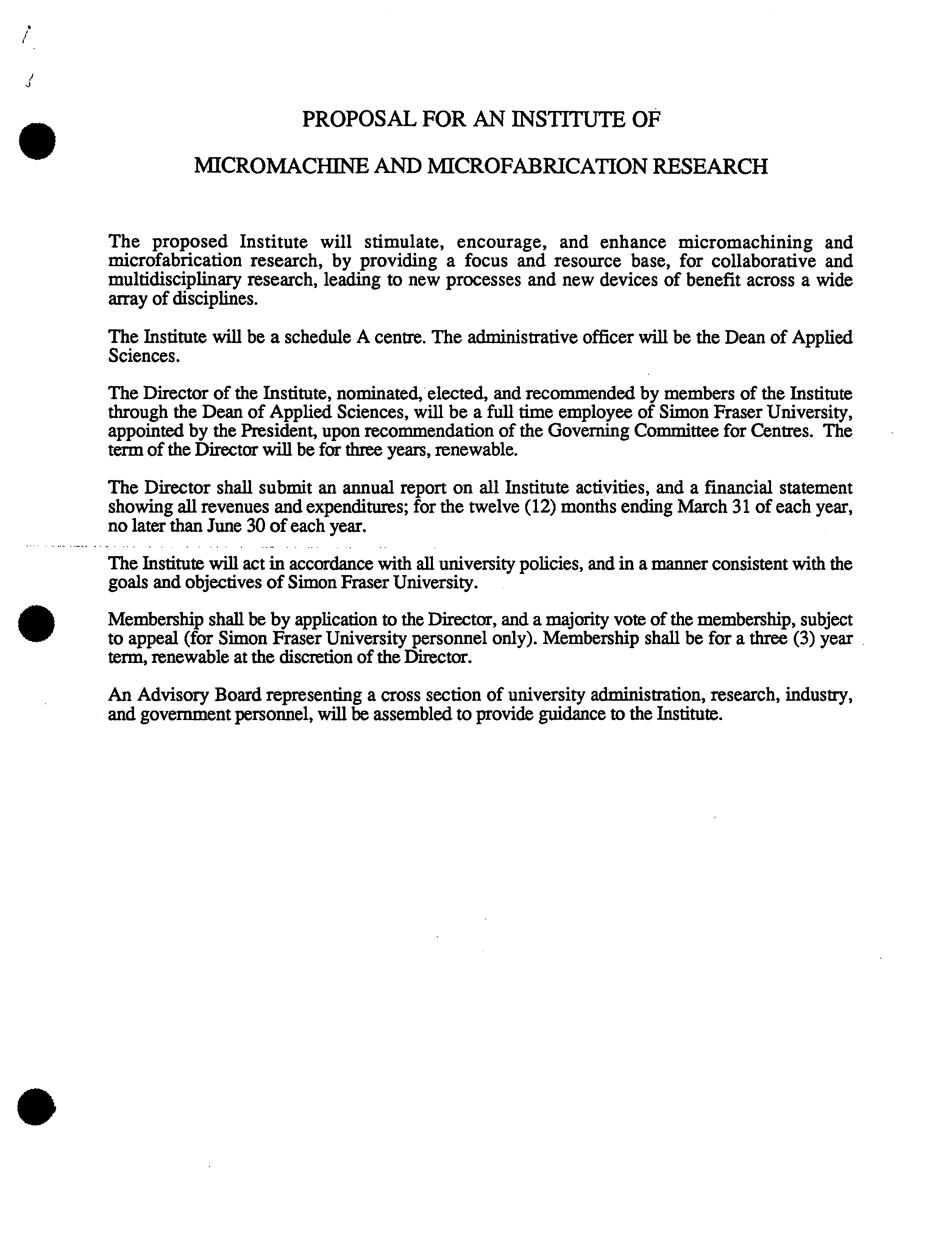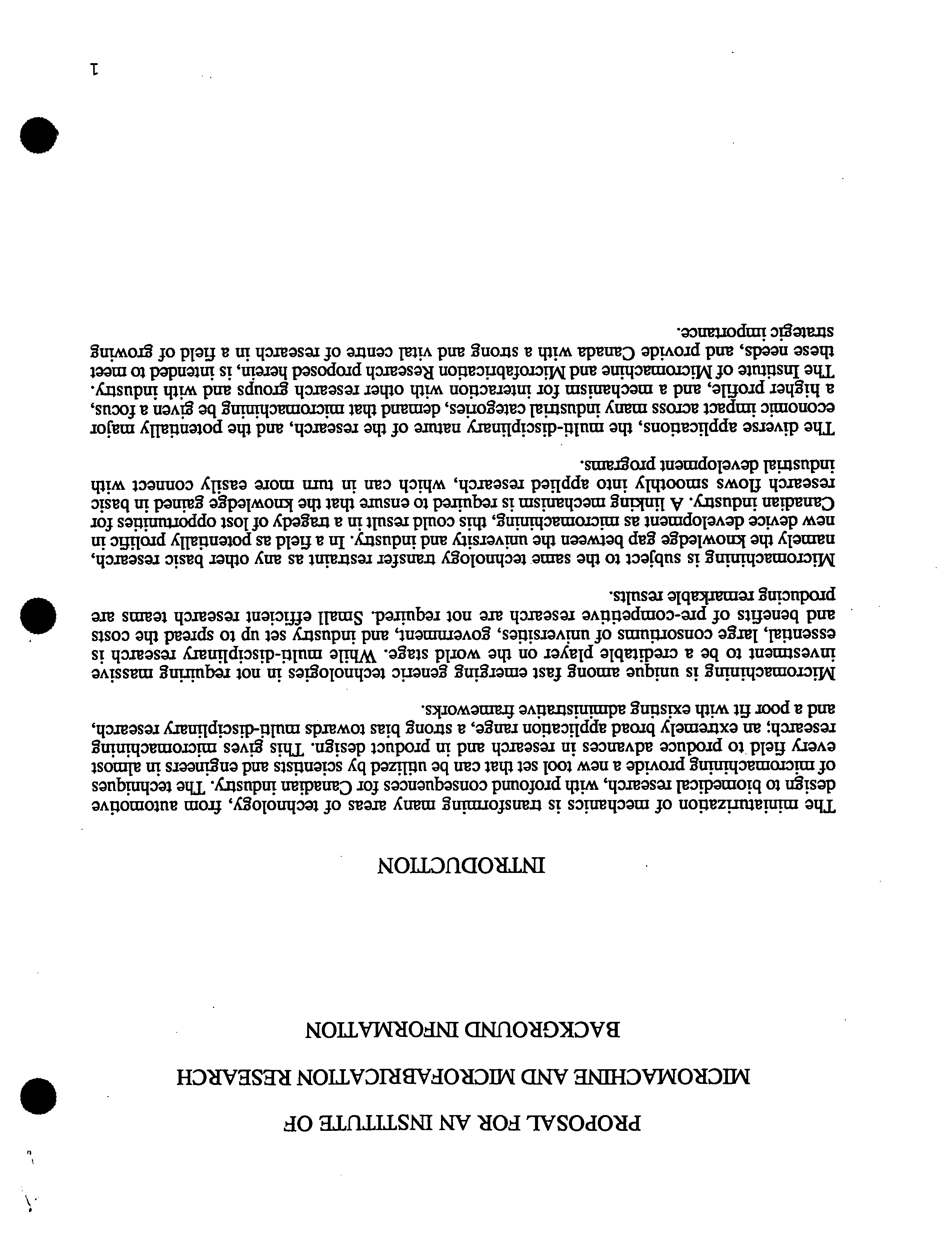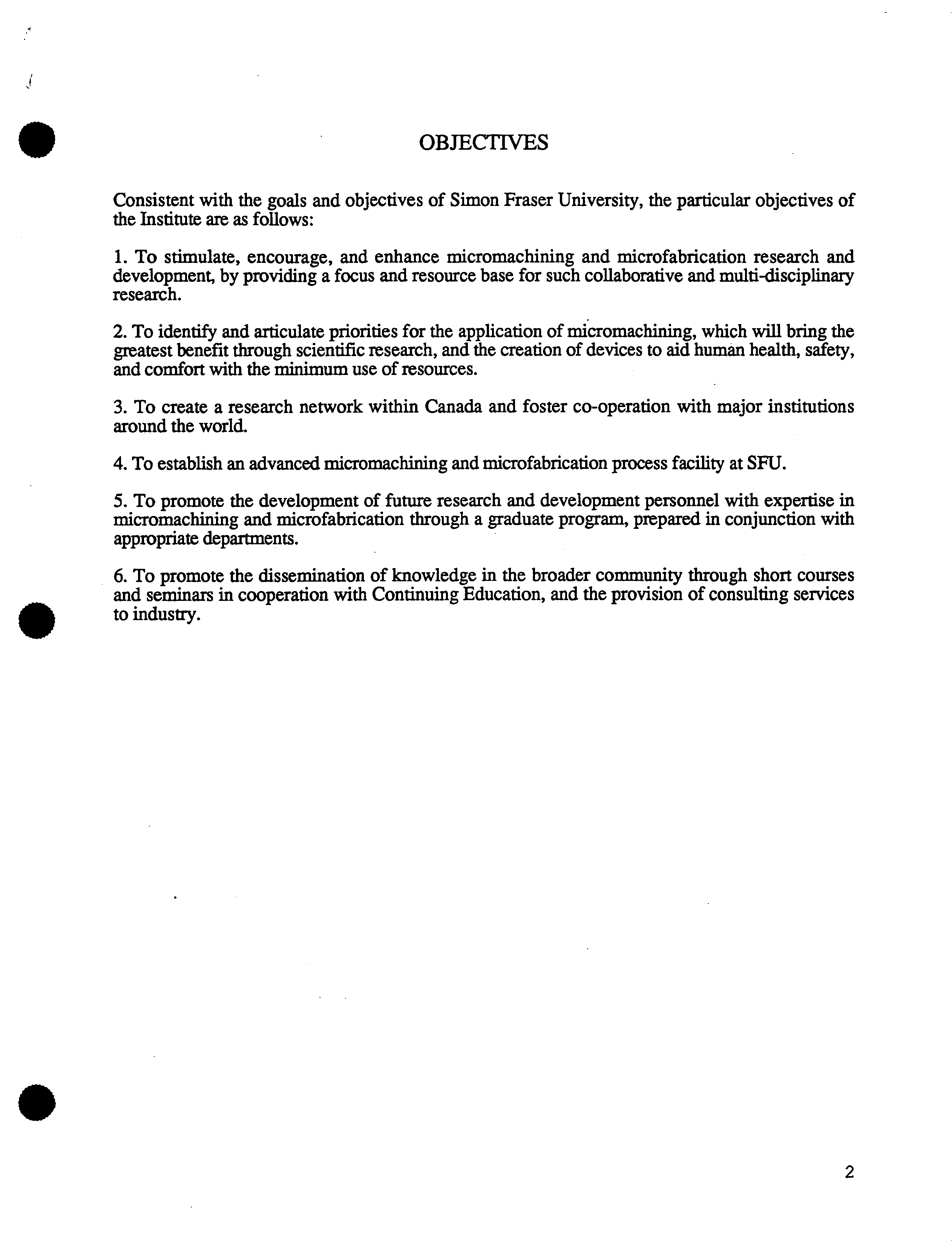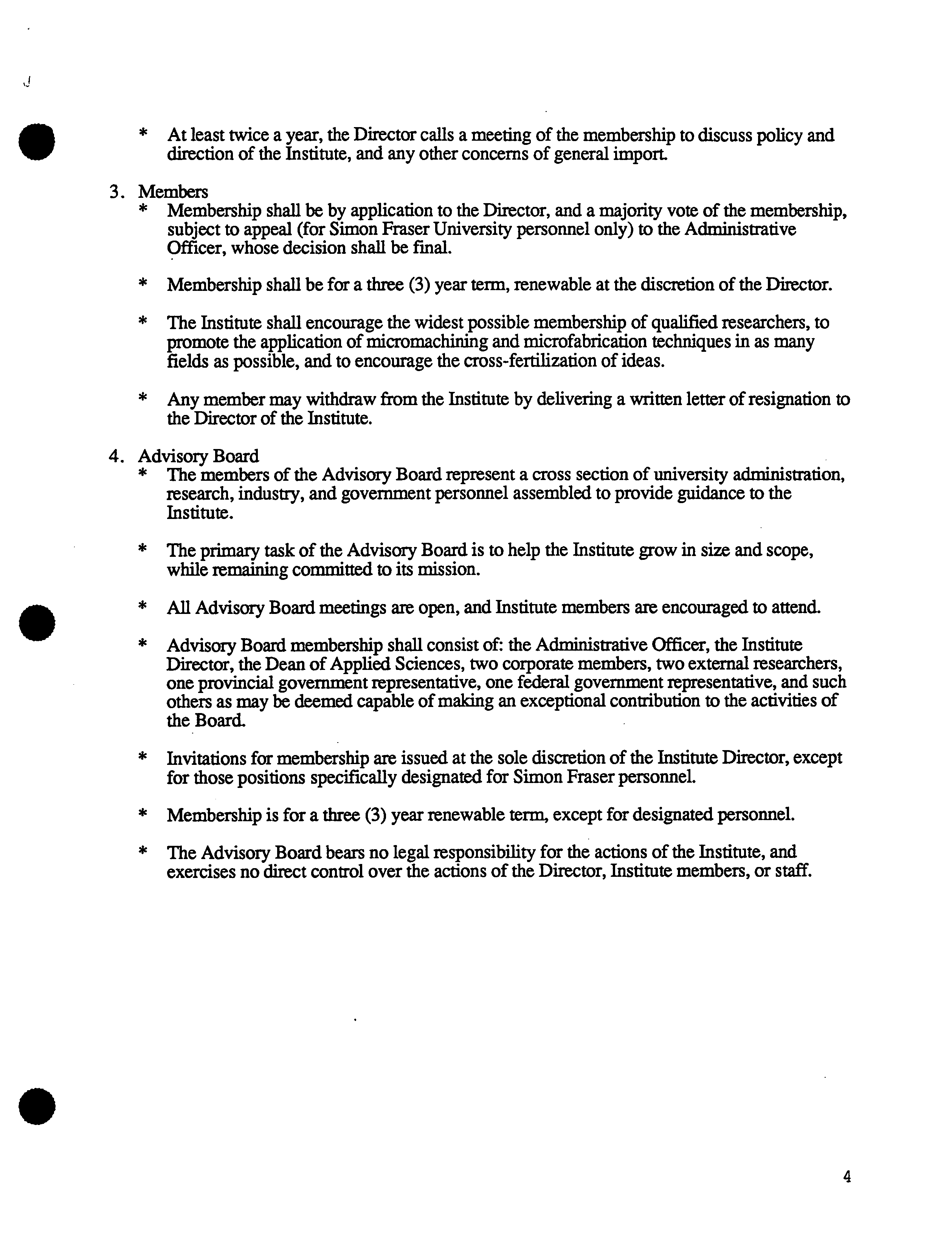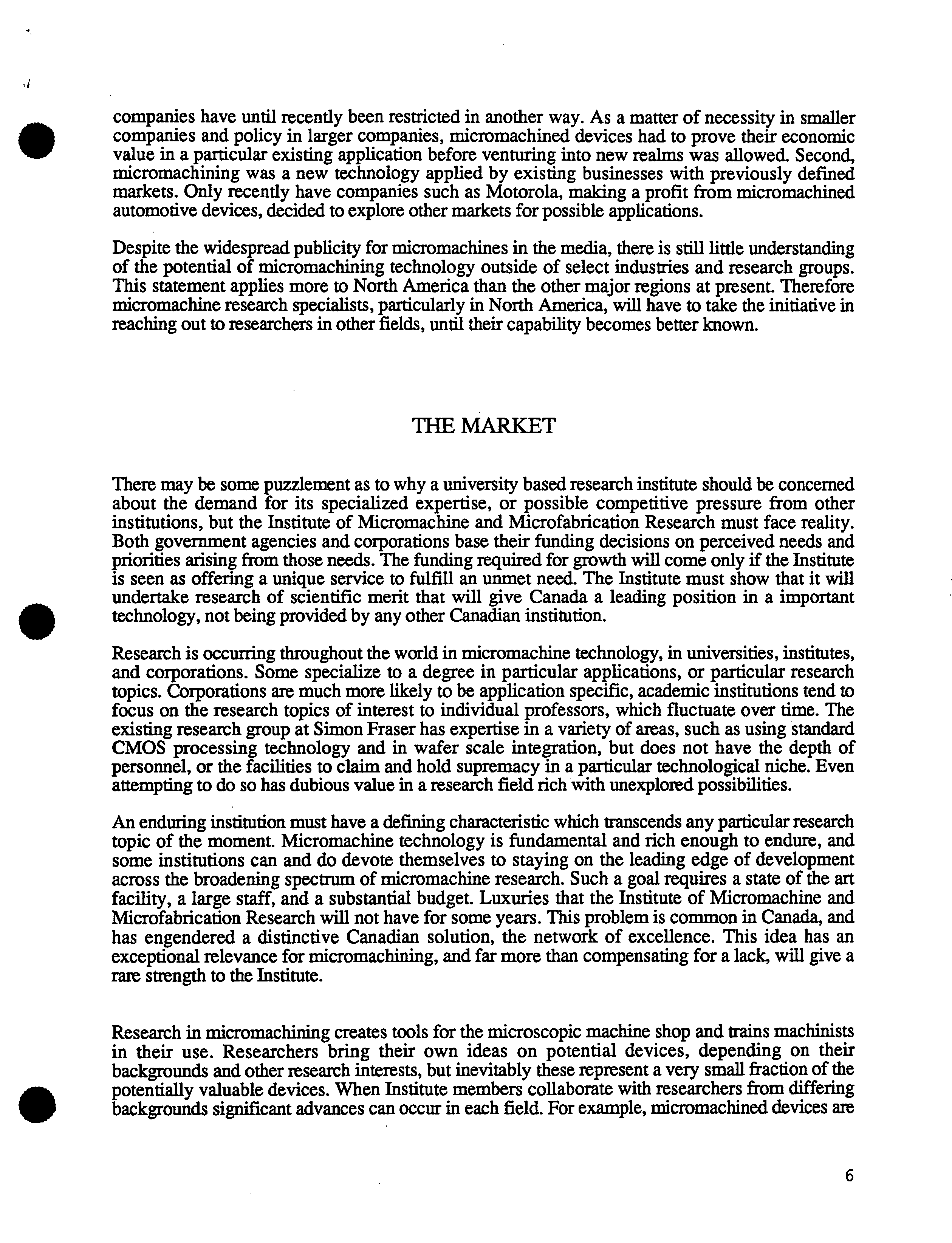.
SIMON FRASER UNIVERSITY
S.92-64
OFFICE OF THE VICE-PRESIDENT, ACADEMIC
MEMORANDUM
To:
Senate
From:
J.M. Munro, Chair, Senate Committee on Academic Planning
Subject:
Institute of Micromachine and Microfabrication Research
Date:
19 November, 1992
At its meeting on November 4, 1992, the Senate Committee on Academic Planning
recommended the establishment of the Institute of Micromachine and Microfabrication
Research.
Motion: That Senate approve and recommend
to the Board of Governors the
establishment of the Institute of Micromachine and Microfabrication
Research and the granting of a Charter to the Institute under the terms
of Policy R.40.O1.
Enclosure
.
0
.
PROPOSAL FOR AN INSTITUTE OF
MTCROMACIIINE AND MICROFABRICATION RESEARCH
The proposed Institute will stimulate, encourage, and enhance micromachining and
microfabrication research, by providing a focus and resource base, for collaborative and
multidisciplinary research, leading to new processes and new devices of benefit across a wide
array of disciplines.
The Institute will be a schedule A centre. The administrative officer will be the Dean of Applied
Sciences.
The Director of the Institute, nominated, elected, and recommended by members of the Institute
through the Dean of Applied Sciences, will be a full time employee of Simon Fraser University,
appointed by the President, upon recommendation of the Governing Committee for Centres. The
term of the Director will be for three years, renewable.
The Director shall submit an annual report on all Institute activities, and a financial statement
showing all revenues and expenditures; for the twelve (12) months ending March 31 of each year,
no later than June 30 of each year.
The Institute will act in accordance with all university policies, and in a manner consistent with the
goals and objectives of Simon Fraser University.
. Membership shall be by application to the Director, and a majority vote of the membership, subject
to appeal (for Simon Fraser University personnel only). Membership shall be for a three (3) year
term, renewable at the discretion of the Director.
An Advisory Board representing a cross section of university administration, research, industry,
and government personnel, will be assembled to provide guidance to the Institute.
S
oumiodwi oi2is
u&oi2 jo poj
V Ul
qozsi jo Q.UUO3 jt
PUR
2uous
13
qpt puj ppoid pu 'spu osoqi
loota o ppuoni
sT
'ui.iq psodoid q31soJ uotwo iqjoioJ put
,
ou j3EtuoI3q1 jo oitupsui ou
Lusnpui 42T
t
puL
,
sdnoj2 ij31SO1 iqo
ipyA
uoioioi
u
.ioj wsuqw
v pule '9jgold iqq
'snooj v uo4 q
iip pu8uIp 'su000
ju1snpu &uux ssoio 2odiu oiuxouoo
o
io1ui
Cjtuod ip pm 'qaisi oxp jo inumudps!p-!nm
'suopz,jdd s.IAp ou
sumj2o.id 1utudojAp jSflU
If liAt
13ouuoo Alis-coiow u.im
U!
utm qoq 'qaisi pjdd
o2u!
(Jq2oows sojj
qisi
U
!
pouTe.9 a2palmou3[q2 imp wnsuo ol pzrnbi si wspmqom 2
utu v
'1'Pul upcu3
ioj stiunoddo 2SOj jo Apa2lm v in qnsai plum sup 'u quio1zpu st
,
3umdojAp 3!AP
MOU
U
ojjoid &pu2od su plaU v uj (rsnpu put
,
1(31S1A!un oxp uuq drS a2polmou3[ aqi Alotnu
'qois1 osq .itpo (ui st
,
mpusaimpueu A2olouqom.oms otp
02
21qns si
q3monTW
•
s2jnsal jqiutuz 2unpoid
on sunol q,zosi 2ugJ
ir
tu
s
p1nbo1 iou
qoisi A Ipodmo3-oid jo sguq put,
ssoo oq2 peids 02 dn is I(I2snpU!
ptm '2UtUUJAO
'S1!S1O
A
!U
n
Jo
SWn!2.IOSUO3
1I
'USS
si qoisi £rjdpsp-jum
2s pjio
uo 1ABjd jqrpio q o 2uw2sArn
AISStU 2uumbw jou tq s2ojoutp iu2 ftliamo ing 2uoum onbmn si
S)j1OAtWJJ o
A p=surruqm
g
uusTxo
qipt ig .iood v pim
'qazsi Xzujdps!p-p jnm spzoi stq 2uoiis '92u1 uouoqdd pwq wixo u qisi
U!UNT.U010!tI
SA2
SqJ
u2sp ionpoid Ut pim qoisi
U!
SOOMApt
,
oonpwd
oi
pg LIA
isotuTe
U!
s1ou!2u put
,
SSrups Aq pzijpn oq uuo
ivp i
g
s
j002
mou u oplAcad 2u
v
mqzmoioim jo
sonbm
qaol oqj
i(IlSflpu!
U iUC3
.ioj souonbsuoo punojoid pm 'q rosicopwoq 02 u2tsp
g
ArOmOn
g
WO1.J
'X2OjOU1j32 jo si Aum
2u
!
uuojstm.0
s! souqDm
JO
UOZJn2U!UPU
QqL
NOLLVIIOtINI CNf101IDXDVff
S
HDIV3SaI NOLLVDNHVdODW GNV aNUlDVWOIIDIW
dO alruILLSM NV 'IOd 'IVSOdOId
0
OBJECTIVES
Consistent with the goals and objectives of Simon Fraser University, the particular objectives of
the Institute are as follows:
1.
To stimulate, encourage, and enhance micromachining and microfabrication research and
development, by providing a focus and resource base for such collaborative and multi-disciplinary
research.
2.
To identify and articulate priorities for the application of micromachining, which will bring the
greatest benefit through scientific research, and the creation of devices to aid human health, safety,
and comfort with the minimum use of resources.
3.
To create a research network within Canada and foster co-operation with major institutions
around the world.
4.
To establish an advanced micromachining and microfabrication process facility at SFU.
5.
To promote the development of future research and development personnel with expertise in
micromachining and microfabrication through a graduate program, prepared in conjunction with
appropriate departments.
6.
To promote the dissemination of knowledge in the broader community through short courses
and seminars in cooperation with Continuing Education, and the provision of consulting services
to industry.
KJ
OC ounr up
1O2J
ou 'j C qai
upu sipuom Z j olp
1OJ ja:)Ujo
OARUSMmapV mp
'2UW22S WT3UVUU R
&IpnjOU
'sAp
I
Oirupsuj uo uodQI junuav ut
,
suiqns
zoioicE u. *
103gJ0 oAuvzsunmpV
oip
tRIM UO3UT1fUO3
m
'fl3USUJ
jo umu
oq
ur uojuopun q o
s2O.UUOO SAQIdd
.io,nQ LL *
jqmuo.i
I
smoA oarip jo uou.mp r ioj oq
hIM
wioi
s
1
1oion( oqL *
SIU3 .IOJ UUUW03
2UIUIO
A
OD
oq o saouoOS pqddy jo
uma
oql
q2noiip
'znsuI ap Jo s.iqww &q
ppuouau000z pue poj 'punnou
oq Mm uosid ppuowmooi oqi
wqi
aq jjp
&mmodd
Ut diou.id qj iooiIQ
st
,
pputuwooi oq oi uos.id v
g
u!Ajuuopl
U! P!fl2
St
'
L93V '°h°d LIdS
osn
jJtM soouoTOS
pjddv
jo uc qj ogjo
Az1sujuipy
oxp &q ppuwmooi
'X1is.IAhufl
isij uotu jo
i(ojdtu
g
mp-flT1J V Si 102301
J
OU
*
102301[Q
•Z
123ffl OAT3W2SWIuJpy
oqi st
,
soouolo
s
poqddV
jo
uoj oqi
qi&
oinioo
y ojnpoqo
oq jp
ompstq
0q2
'sotusuj pu
0I2UO3
.ioj çy Am
od
X2ISIO
A
!Ufl i0S1d
uoul!S .iopufl *
103J(J O
A
SWIUJPV
I
HS1K3YE ' 3DN3Bd3I dO S3L
----------- : -----------
2U2S!SSV
0A13I1SIUItUPV
XlosApV
JaOUJO
OAl2Bi2SWIWpV
fldS
.aufmfllLLS
.
* At least twice a year, the Director calls a meeting of the membership to discuss policy and
direction of the Institute, and any other concerns of general import.
3.
Members
* Membership shall be by application to the Director, and a majority vote of the membership,
subject to appeal (for Simon Fraser University personnel only) to the Administrative
Officer, whose decision shall be final.
* Membership shall be for a three (3) year term, renewable at the discretion of the Director.
* The Institute shall encourage the widest possible membership of qualified researchers, to
promote the application of micromachining and microfabrication techniques in as many
fields as possible, and to encourage the cross-fertilization of ideas.
* Any member may withdraw from the Institute by delivering a written letter of resignation to
the Director of the Institute.
4. Advisory Board
* The members of the Advisory Board represent a cross section of university administration,
research, industry, and government personnel assembled to provide guidance to the
Institute.
* The primary task of the Advisory Board is to help the Institute grow in size and scope,
while remaining committed to its mission.
•
* All Advisory Board meetings are open, and Institute members are encouraged to attend.
* Advisory Board membership shall consist of: the Administrative Officer, the Institute
Director, the Dean of Applied Sciences, two corporate members, two external researchers,
one provincial government representative, one federal government representative, and such
others as may be deemed capable of making an exceptional contribution to the activities of
the Board.
* Invitations for membership are issued at the sole discretion of the Institute Director, except
for those positions specifically designated for Simon Fraser personnel.
* Membership is for a three (3) year renewable term, except for designated personnel.
* The Advisory Board bears no legal responsibility for the actions of the Institute, and
exercises no direct control over the actions of the Director, Institute members, or staff.
.
4
.
.
S
nq
'sou
g
dwoo utp sps1Arnn o .iom 43flUI suiiod
.11
stqj so1sp pou1tpwo13uu
Jo uoojdd puu
qoi2
otp
g
uniq!qul
Si
slip
puv
pjnoqs Amp
oaaop
otp oi sisn joo
oq
j
ipjmiotpo2oj 2u'
q
8 jou on sio3pm
l
oo qj tuiou otp
20U
on asotp IoA '.moo spuno32pq
2uijjp Jo siqoi si uM3,oq suoi21oqjJoo uoqm po3npold an sjnsi &quohou
l
aolouqoai zip jo wmw i(iujdpsip-tijnm oqi suo iutu 2up owoiou uo jopi Iwou XIA
uopit iou si puoz podxo
swss xjdwoo jo uoonpoid
O2 .103
£issou 'siomo
uo sisrqduao
iuTmojS v pim
I
ss000id uotimw otp jo llnsw jnuu lo 'smosis spzo2
SOAp
jdws mo.zJ
:opnl3ui luoplAo spuij -Bojouqm otp jo indua pewdsopyA olp jo
AIOUaI pu 'qoi2 ioj uouipuoo 4(rss3ou v Ajqqoid 'jpusqns
5T
qaisai
Olp
jo
-mosaid iv suo2i oomp
q zip
UT
2Uinb iCjqnoi 2uioq,
,
4puianb
jjCIAO qrp
'udç ul Xjpidv isom sdqid Tui
.
pudxo
s!
qaiosai ourpcmoiom 'S'
T
2S3 ipnoS pim odamg
'siqds ormouo3oi6fruinipo oq u s1oo
Rv
uT
q&oi2
Cps
zisuomp sdoqs.1oM
sd tp!m suosuEdtuo3somp puiqomoioim utuuoo s23npold
u!.UU3JnuW
Jo ssunq
0q2
UT
ic1utuop1d
.10
XAiSnjoX
puu
sUEd1xIo3 qi jo UA as'i
qovmomTEa
UI
PQAJOAUT AJOAUOV oq oi
UM0U
si Cudwoo upu ou pu 'pzuosidi sudtuoo
uU1pu3
OU
wom
ojoiLL
qj iuouaU.IQA02 ouo put
,
piusidi1M SI2IS1AWfl
UUTPUJ
MO
d
T
OP
O
MV W
O
N
U
T
psq siudmoo
8C
puv suTs.IA!un
9E
wwj sioqozsi iip siomo
puv siosus os pijos uo doqspot uouuI quo
(z661)
IUO32I
V P!
.
'°
ij2 puno.i qaisi
Uupm0i3itu Jo A1IS1AIp pu
unb OtP
U
q2Atol2
JO
UIUIUO1!AUO
urnwo
ifiM oiTupsuj qj.
1NNOIIAM HI-U
*IUOP!AQ Si 1S1o2ui pun 'pntu uoq
tq soumbuo X1nuu1ij1 ss s uoz nso 2unboiJ 1qM '3Iur
quo piSnO
on-u spoq &injnopid
siia
qDznoso.I 17auopdo3xo 421M
imum
su.iq uojjjn qons O.IoqM 'q2nos
oq Mm suopluis
u
! ioqio qiuit suoTjIJJn 'ouupsul Ot Jo jno
LmW
T
.Id
s uopioqoo otqs
SNOLLVflT44V
3fl
lg
uuooul2ua Inp3olajo -idoa
IOSSOJO.Id 1U5ISSV
iou.mj uqoJ
fkTS '
U0
T
0
S
2uuozuT2ug Jo looT43S
IOSSOJOJd mlai3ossv
Z31M)J MOIpU\f
lidS
'O3UOi35 2uuoQuT2u3 JO jooqo
lOS5OJOld OiOOSSy
&mol iioq
lidS
103Uop u
!
.Ioou
T
u
3J
O
1ooqS
IOSSOJO.Td O130SSV
pp
(z
i
A
S
3TO1W
lidS
1
03UO35
g
uuooUT2ua JO looqos
JOSSOJOId 2Un2SISSV
II1
M
SOU
1
1d
W
lidS
10UoiO5 2uuoou
T
2u
3
JO jooqo
.
IOSSO
J
OJ
d
OIOSSV
unwdtrj uuojü
SMIEMaK
ioid Or
g si splag
q3msoi put
,
SUO
T
UU
P
SU
!
°n°
UT
S
On
2
O
IIO
3
qit qaioso.i
wtof qnoiq dsxoqmom oqi jo uo!sudx3 Mojoq po2sij o.in mrupsuj oqi Jo sioqmow io2iq3 OIJJ
uu::ii
companies have until recently been restricted in another way. As a matter of necessity in smaller
. companies and policy in larger companies, micromachined devices had to prove their economic
value in a particular existing application before venturing into new realms was allowed. Second,
micromachining was a new technology applied by existing businesses with previously defined
markets. Only recently have companies such as Motorola, making a profit from micromachined
automotive devices, decided to explore other markets for possible applications.
Despite the widespread publicity for micromachines in the media, there is still little understanding
of the potential of micromachining technology outside of select industries and research groups.
This statement applies more to North America than the other major regions at present. Therefore
micromachine research specialists, particularly in North America, will have to take the initiative in
reaching out to researchers in other fields, until their capability becomes better known.
THE MARKET
There may be some puzzlement as to why a university based research institute should be concerned
about the demand for its specialized expertise, or possible competitive pressure from other
institutions, but the Institute of Micromachine and Microfabrication Research must face reality.
Both government agencies and corporations base their funding decisions on perceived needs and
priorities arising from those needs. The funding required for growth will come only if the Institute
is seen as offering a unique service to fulfill an unmet need. The Institute must show that it will
undertake research of scientific merit that will give Canada a leading position in a important
technology, not being provided by any other Canadian institution.
Research is occurring throughout the world in micromachine technology, in universities, institutes,
and corporations. Some specialize to a degree in particular applications, or particular research
topics. Corporations are much more likely to be application specific, academic institutions tend to
focus on the research topics of interest to individual professors, which fluctuate over time. The
existing research group at Simon Fraser has expertise in a variety of areas, such as using standard
CMOS processing technology and in wafer scale integration, but does not have the depth of
personnel, or the facilities to claim and hold supremacy in a particular technological niche. Even
attempting to do so has dubious value in a research field rich with unexplored possibilities.
An enduring institution must have a defining characteristic which transcends any particular research
topic of the moment. Micromachine technology is fundamental and rich enough to endure, and
some institutions can and do devote themselves to staying on the leading edge of development
across the broadening spectrum of micromachine research. Such a goal requires a state of the art
facility, a large staff, and a substantial budget. Luxuries that the Institute of Micromachine and
Microfabrication Research will not have for some years. This problem is common in Canada, and
has engendered a distinctive Canadian solution, the network of excellence. This idea has an
exceptional relevance for micromachining, and far more than compensating for a lack, will give a
rare strength to the Institute.
Research in micromachining creates tools for the microscopic machine shop and trains machinists
in their use. Researchers bring their own ideas on potential devices, depending on their
backgrounds and other research interests, but inevitably these represent a very small fraction of the
•
potentially valuable devices. When Institute members collaborate with researchers from differing
backgrounds significant advances can occur in each field. For example, micromachined devices are
6
L
t(2M
PM L
I
IOOSST
S2SOO jflU oqi
8UpAO3 ST
omomSpoT
jo nj qi mo.g
2u
!
pun
j
dn-=S
ctpj
l
qonoswio2mj 'ou v pue 2utudnb I!do mou
JO
osn put
,
O3UI1U1EtU '1023011p -aqliojqvq3 qoiosoi v jou qsqs 'suotupsu iq2O qt
juuosid jo
ouqoxo opnpu sqj SjAJ 2UUS!xo oAoqt
,
pue io 2UTpun; ognbai sAuoofqo
j'1AS
'SM01
2TU2SUJ
QTP
SV
1AMOH iu!punj pu 'jouuosid 'sjpj ups!x
o
ozi
n
sop!Apov qoisoi zouTs 'sisoz Atqnd .Ioultu ioj OAL
I
S
opnq ou snnbo.i &jj
g
uiut
O
IMP
SU
I
OU
laDafla
sutussss im puv suoudo Aidoid njpui 'sQmsopsp
2IA i
JJs put
,
supn2s
1
X21nJ 2upsissr puia 2uislApt
,
'uozu2io oovaos v st
,
sido ooTjjo
sqj siuutd j.usnpu put
,
ssrnsnq qpt suopji 2upjloM
g
tnosuo
g
uTusTTqmso ul JJ2S pug
X2[noJ 525 ss 'i2ojouqoj ptm 2upqwjL
l
uopronpg PootmApV jo
DEL
oxp Aq piioddns
''!JTO
uosmrl
c.uSflpUTJJc2s1A!ufl
oTIL
1JS U.I2
8OJOUq32 1flJ5S933fl5 wnsuo 02 j2OP
LISSOU
q2
2Up1OOo
02
S1
fl
2U
A
!
U
Q
1S
P
°UJO
UOSfl
i(I3SflpUI/I2S1A!Ufl
qnoiq
jioM
jjIM MtUj3SUj q2 '10AOpUO S1q2
PIE
Oj
p23I1m
uq
JO
1qd3
qo
oi
22
souwoiotu oonpoad
02
sopT
s jo
g
ujos ut 2szu u
jjp.t £usnpu
podx s 2 'pqsjqms s 1n23su[
qi ouo uounJ .xjsu.0 A2ojoui.po
sil ol pioi ut
oq ll!m orusui oqi jo ioodsvizqiouV
.povj oxp &npi2dn ioJ spunj jEuusqns qi
pop
.1
pu 'smBl2o.Id
.iossoons .io uri2oid omollona jo onuoj qi .ipun pozu2o1 &jwioJ q pjnoqs nsui
otri
IMP '1uouuuA02 Itl0p
l
aj
01P 02 3ui 02
so 2uoi2s £IA
'8
2Aq jjt 'iuimw siqi in 2uuop.ounJ
pu
S
2fl2SUJ q2 ou
.IS21d
uOw 2 psq OU1I3X JO
IU3
O2J P
5
JO
UO3O13 o
tp
sf 'spjog .iipo
in
s.iqwm mo 2UPWs Jo Bw
mvs otp uio.g iUzuoq £IIpsqns v
suidiosip qoissi uo ioq2 u sOuAp
03 snb!uq pus sss000zd
osq2zqpn siqwtu iotpej *Mmpsul oq jo aioo atp usuiz iq pus
jo snbuqam
pus sss000id zip sousps qaissai zIouj ojoi jounsi
pvoAvq oouoTOS
JO ioo1iS
uqip sioquioui 'soujdpsp pus suontumsu Ausui sso.ios psids am p iodx
s dqszqtum j'u
os
02
qi ugsptqo
'102J5 fljflOS aq 02 ioodxo uso s.ioquioux 'psids
,
41qsds3
S2
pus 2fl2pSUJ 0q3 JO pjAt0U)J
sv
iuwdojAop op MQU
uT
UI2
qipt mriog
a
lloo
.10
's2I
flS1
12
Jo asn o3pm U5) OqM 'spjj
iqio
uT
iuuosid qoissi 2fl0 3loos 02 uosqo us si uopo.usi
iU0
2SO12U J3 Ssno.Is
sqi pjaj otp
uu
odo3 &us onsind
02
=.rj siqwm Mrupsuj
oip 2utsoj
'u1p
oms alp 25
'Jos2! .IOJ oi njnij pus nbwn s qsjqsmso uso nsuj tp 'i(2o0uqo2 42 Jo
OltUSU
ICI5U!jdpsfl)
-U'[flui aip pus
'S pij
qoivsi
110
02 snbuqo2 ouTjD5mo1U Jo OfljSA 012
U0 UpC3j
'EEL
uotounJ
ur!.Id
.Ioq2 spjj ioq2o mo.ij
s.iq31sos1
tplm uous.ioqso3 osm 03 UMOU3J
ST
uop
fl
2!2su! .iqmo ON 2uuqostu0nu1
JO
ppj oxp Jo U0!SUSdXO
OARRAOUUI .IOJ MIS 2utpsj
01P
02 &ppmb oi2 tiED qaiss>j uouu:)!jqvjomr
W
pus 2uuuqosuxoiory
.IOJ
Mtupsuj 0q2 'spjoj
Auna
uxoij
juuosid qaisosoi jo
dnoi2
N
2
!
q
"
1IPI5
UIUUP5W Jo pou s
sr &IIuoUDund
•
SSUAuoUpS!P 02
2f lO1
s pus 'suopsi
S
3TU2SUJ 42 SA2
spi 03UQUQOXQ jo
j1ou
Qtp qu
jo zrusu Lrsuiidtosip-uinm
qi
uuqtuo
SLiOA03Stp
/AU 02
S2S1UL35W01O1UT qsnd WM suspup pus sitpissi jsoptu
UIQJJ
spuswp omp tusS oqi ms
'suous3ljdds lroTuq3 pus
qoisi
5Otpw
UI
sz)usAps OSfl53 03 p2odx
organizing the Institute.
All
subsequent funding for the Institute, which is incremental to existing
. levels of support, should come from sources outside Simon Fraser University. The exception
being the normal internal applications for funding to which all personnel, groups of personnel, and
institutes are entitled to apply.
.
0


